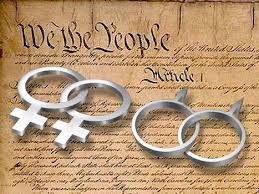Cross posted from The Stars Hollow Gazette
 The Supreme Court ruled on two important cases for the LGBT community: Windsor v. U.S., addressing the Defense of Marriage Act, and Hollingsworth v. Perry, addressing California’s Proposition 8.
The Supreme Court ruled on two important cases for the LGBT community: Windsor v. U.S., addressing the Defense of Marriage Act, and Hollingsworth v. Perry, addressing California’s Proposition 8.
On DOMA, which was signed into law by Pres. Bill Clinton in 1996, the court ruled (pdf) that same-sex spouses legally married in a state may receive federal benefits. Justice Kennedy delivered the court’s opinion, and was joined by Justices Ruth Bader Ginsburg, Stephen Breyer, Sonia Sotomayor and Elena Kagan. Chief Justice John Roberts and Justices Antonin Scalia and Samuel Alito all filed dissenting opinions. While the ruling is a victory on the federal level, the 5- 4 ruling does not effect a state’s right to ban same sex marriage.
“The federal statute is invalid, for no legitimate purpose overcomes the purpose and effect to disparage and to injure those whom the State, by its marriage laws, sought to protect in personhood and dignity,” Justice Anthony Kennedy wrote in the majority opinion. “By seeking to displace this protection and treating those persons as living in marriages less respected than others, the federal statute is in violation of the Fifth Amendment.”
The plaintiff who brought the case, Edie Windsor, 84, will now get her refund for the $363,000 in federal estate taxes she paid after her spouse, Thea Spyer, died in 2009.
In the Prop 8 case, that was argued before the court by attorneys, Theodore Olson and David Boies, the court decided, again by a 5 – 4 decision, that the opponents of same sex marriage have no standing to sue. The ruling allows gay couples in California to marry.
“We have never before upheld the standing of a private party to defend the constitutionality of a state statute when state officials have chosen not to,” Chief Justice John Roberts wrote in the majority opinion. “We decline to do so for the first time here.”
Roberts was joined in his majority opinion by Justices Ruth Bader Ginsburg, Antonin Scalia, Stephen Breyer, and Elena Kagan. Justice Anthony Kennedy filed a dissenting opinion, joined by Clarence Thomas, Samuel Alito and Sonia Sotomayor.
The judgement of the Ninth Circuit was vacated and the case remanded with instructions to dismiss the appeal for lack of jurisdiction.
California voters added Proposition 8 to the state’s constitution in 2008 through a ballot initiative that reversed the state Supreme Court’s recognition of same-sex marriage earlier that year. Two same-sex couples challenged the ban in federal court, and by the time their suit reached the justices, two lower courts had declared it unconstitutional.
After the disappointing ruling yesterday striking down a key part of the Voting Rights Act, this is truly a great day for equal rights in the US.


 The Supreme Court ruled on two important cases for the LGBT community: Windsor v. U.S., addressing the
The Supreme Court ruled on two important cases for the LGBT community: Windsor v. U.S., addressing the 

